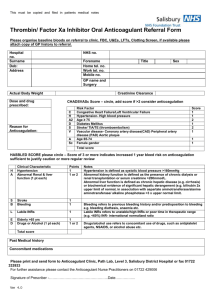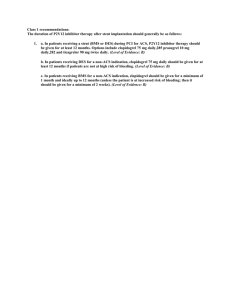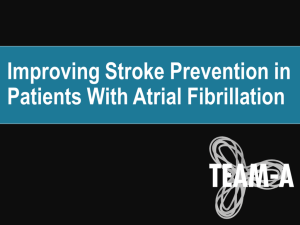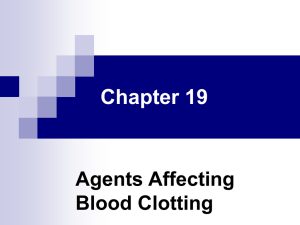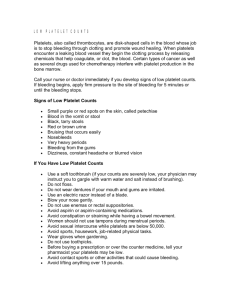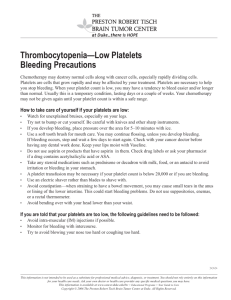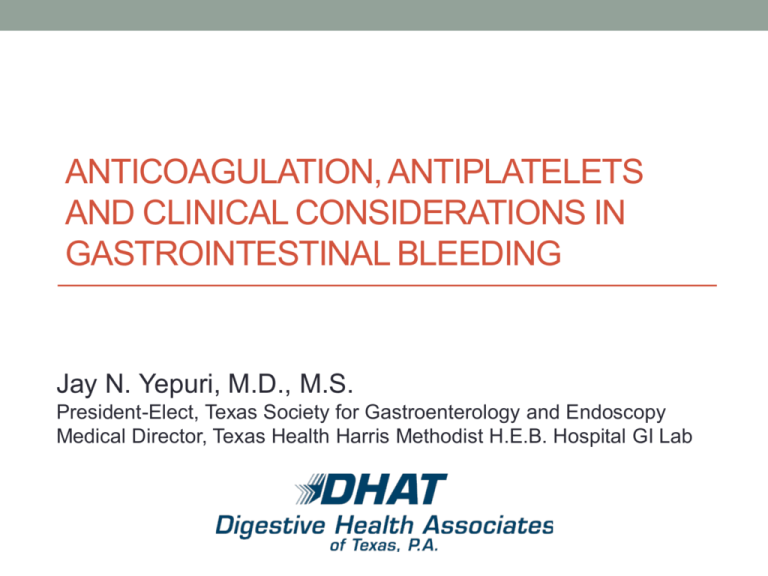
ANTICOAGULATION, ANTIPLATELETS
AND CLINICAL CONSIDERATIONS IN
GASTROINTESTINAL BLEEDING
Jay N. Yepuri, M.D., M.S.
President-Elect, Texas Society for Gastroenterology and Endoscopy
Medical Director, Texas Health Harris Methodist H.E.B. Hospital GI Lab
Objectives
Review the causes and basic clinical
considerations in the management of nonvariceal upper and lower gastrointestinal
bleeding
Identify the current anticoagulant/antiplatelet
agents available in the U.S.
Discuss the effects of current
anticoagulant/antiplatelet agents on the
management of non-variceal gastrointestinal
bleeding
Causes - UGIB
Peptic ulcer disease — 55%
Esophagogastric varices — 14%
Arteriovenous malformations — 6%
Mallory-Weiss tears — 5%
Tumors and erosions — 4% each
Dieulafoy's lesion — 1%
Other (Cameron lesions, GAVE, PHG, Hemobilia, AEFs)
— 11%
Jutabha R, Jensen DM. Management of upper gastrointestinal bleeding in the patient with chronic liver disease.
Med Clin North Am. 1996;80(5):1035.
Causes - UGIB
Proportion of cases caused by PUD has declined
PUD = 21%
Nonspecific mucosal abnormalities = 42%
Esophageal inflammation = 15%
Variceal = 12%
Other causes (AVM, Mallory-Weiss tears, and
tumors) each accounted for less than 5% of cases
GUs were more common than DUs
representing about 55% of all ulcers
Boonpongmanee S, Fleischer DE, Pezzullo JC, Collier K, Mayoral W, Al-Kawas F, Chutkan R, Lewis JH, Tio TL, Benjamin SB. The
frequency of peptic ulcer as a cause of upper-GI bleeding is exaggerated. Gastrointest Endosc. 2004;59(7):788.
Causes - LGIB
Incidence of hospitalizations for LGIB is similar to that of
UGIB, largely due to a decrease in upper GI events
Laine L, Yang H, Chang SC, Datto C. Trends for Incidence of Hospitalization and Death Due to GI Complications in the United States From 2001 to 2009.
Am J Gastroenterol. 2012 Jun;
Lanas A, García-Rodríguez LA, Polo-Tomás M, Ponce M, Alonso-Abreu I, Perez-Aisa MA, Perez-Gisbert J, Bujanda L, Castro M, Muñoz M, Rodrigo L, Calvet X, Del-Pino D,
Garcia S. Time trends and impact of upper and lower gastrointestinal bleeding and perforation in clinical practice. Am J Gastroenterol. 2009 Jul;104(7):1633-41. Epub 2009
May 05.
Hematochezia
Diverticulosis – 5 to 42 percent
Ischemia – 6 to 18 percent
Anorectal (hemorrhoids, anal fissures, rectal ulcers)
– 6 to 16 percent
Neoplasia (polyps and cancers) – 3 to 11 percent
Angiodysplasia – 0 to 3 percent
Postpolypectomy – 0 to 13 percent
Inflammatory bowel disease – 2 to 4 percent
Strate LL. Lower GI bleeding: epidemiology and diagnosis. Gastroenterol Clin North Am. 2005;34(4):643.
Hematochezia
Radiation colitis – 1 to 3 percent
Other colitis (infectious, antibiotic associated,
colitis of unclear etiology) – 3 to 29 percent
Small bowel/upper GI bleed – 3 to 13 percent
Other causes – 1 to 9 percent
Unknown cause – 6 to 23 percent
Strate LL. Lower GI bleeding: epidemiology and diagnosis. Gastroenterol Clin North Am. 2005;34(4):643.
Initial Evaluation
H&P
Labs
NGL
UGIB predictors = melena, melenic stool,
blood or CGE during NGL, BUN/Cr > 30
Severe UGIB = BRB on NGL or PR,
tachycardia, HgB < 8g/dL
Srygley FD, Gerardo CJ, Tran T, Fisher DA. Does this patient have a severe upper gastrointestinal bleed?
JAMA. 2012 Mar;307(10):1072-9.
H&P
NSAIDs, ASA, anticoagulants,
antiplatelets
EtOH abuse, prior GIB, liver disease,
coagulopathy
Abdominal pain = ? perforation
Tachycardia, orthostatic BP changes,
hypotension, rectal exam
Labs and Testing
Type and screen (or type and cross
match for unstable/high-risk patient)
HgB, Platelets, PT/INR, LFTs, BUN/Cr
NGL – can be helpful to clear stomach
15
Management - Transfusion
Hemodynamic instability despite IVF resuscitation
Hgb < 9 in high risk patients (e.g. elderly, CAD)
HgB < 7 in low-risk patients
FFP for coagulopathy
Platelets if < 50k or concern for platelet dysfunction
(antiplatelets, uremia)
Coagulation Cascade
Anticoagulant Use
Anticoagulant drugs help prevent the
development of harmful clots in the
blood vessels by lessening the blood's
ability to cluster together
Anticoagulant Use
The function of these drugs is often
misunderstood because they are
sometimes referred to as blood thinners;
they do not in fact thin the blood
Anticoagulant Use
These drugs will not dissolve clots that
already have formed, but it will stop an
existing clot from becoming worse and
prevent future clots
History of Anticoagulants
In 1960, DW Barritt and SC Jordan performed
the first randomized trial showing the efficacy
of anticoagulant therapy in the treatment of
venous thromboembolism
Since then, important therapeutic advances
have been made in the treatment of deep
venous thrombosis and pulmonary embolism
History of Anticoagulants
Warfarin has been the
drug of choice for the
prevention and
treatment of arterial and
venous thrombotic
disorders for more than
40 years
It was initially marketed
as a pesticide against rats
and mice and is still
popular for this purpose
Anticoagulant Drugs
Heparin and warfarin are the two
traditional anticoagulants
Anticoagulants are used for acute coronary
syndromes, deep-vein thrombosis (DVT),
pulmonary embolism (PE), and heart
surgery
Also given to certain people at risk for
forming blood clots, such as those with
artificial heart valves or who have atrial
fibrillation (AF)
Anticoagulant Drugs
Thrombus - A blood clot that forms
abnormally within the blood vessels
Embolus - When a blood clot becomes
dislodged from the vessel wall and travels
through the bloodstream
The future for anticoagulants
Limitations of warfarin have fostered a
great interest in the development of
novel anticoagulants for oral use to
potentially replace warfarin
Various inhibitors against molecular
targets that play a pivotal role in the
coagulation cascade
Platelets
Platelets
First recognized as a special class of blood
cells in 1882
“Born” in the bone marrow
Over a trillion in the average adult
Lifespan is about a week
http://www.hematology.org/About/History/50-Years/1525.aspx
Platelets
Two mechanisms:
Adhesion (sticking to the injury)
Aggregation (attracting other platelets)
Platelets stick to plaque in the arteries
leading to MI and CVA
Antiplatelet therapy is utilized both for the
treatment and prevention of MI and CVA
http://www.hematology.org/About/History/50-Years/1525.aspx
Antiplatelets
ASA was and is the first effective antiplatelet
drug
Effects have been known for over 50 years
Abiciximab (1994) – next major advance
glycoprotein (GP) IIb/IIIa complex
antibody
Clopidogrel (1998)
ADP receptor antagonist
http://www.hematology.org/About/History/50-Years/1525.aspx
30
Antiplatelets - clopidogrel
Issued a black box warning from the FDA in March
2010
2-14% of the US population who have low levels of the
CYP2C19 liver enzyme needed to activate clopidogrel
may not get its full effect
PPIs are also metabolized via this enzymatic pathway
Possible PPI – clopidogrel interactions
https://en.wikipedia.org/wiki/Clopidogrel
Anticoagulation and Antiplatelets
Management of Antithrombotic Agents for Endoscopic Procedures. Gastrointest Endosc 2009;70:1061-1070.
Prasugrel
Approved by the FDA in July 2009
ADP receptor antagonist
Prodrug
As opposed to clopidogrel, PPIs do not reduce the
antiplatelet effects of prasugrel
Reduces platelet aggregation by irreversibly binding to
P2Y12 receptors
Elimination ½ life of 7 hours
reduction of thrombotic cardiovascular events
(including stent thrombosis) in patients with ACS who
are to be managed with PCI
http://www.effienthcp.com
Ticagrelor
Approved by the FDA in July 2011
Indicated for:
prevention of thrombotic events (CVA or MI) in
patients with ACS or an STEMI
Typically combined with ASA 81mg (unless
contraindicated)
Metabolized via CYP3A4 and excreted via the liver
https://en.wikipedia.org/wiki/Ticagrelor
34
Ticagrelor
CYP3A4 inhibitors (ketoconazole and grapefruit juice)
can potentiate its effects
Mechanism of action similar to prasugrel
However, ticagrelor has a binding site different from
ADP (so blockage is reversible)
Acts faster and for a shorter period of time than
clopidogrel
https://en.wikipedia.org/wiki/Ticagrelor
Newer Agents
Edoxaban
Direct factor Xa inhibitor
Approved by the US FDA in January 2015
Treatment of DVT and PE following 5 to 10 days of initial therapy
with a parenteral anticoagulant
To reduce the risk of CVA and systemic embolism in patients with
non-valvular atrial fibrillation (NVAF)
Contraindicated in patients with NVAF with a CrCl >95
ml/minute (increased risk of ischemic stroke compared to
warfarin)
Giugliano RP, et al. Edoxaban versus Warfarin in Patients with Atrial Fibrillation. N Engl J Med 2013; 369:2093-2104
New Oral Anticoagulants
NO REVERSAL AGENTS!!!
Interaction between anticoagulant drugs and the coagulation cascade
Sabir, I. et al. (2014) Oral anticoagulants for Asian patients with atrial fibrillation
Nat. Rev. Cardiol. doi:10.1038/nrcardio.2014.22
The coagulation cascade, platelet activation pathways, and targets of antithrombotic agents.
inhib indicates inhibition; LMWH, low–molecular-weight heparin; AT, antithrombin; vWF, von
Willebrandt factor; TxA2, thromboxane A2; and ADP, adenosine diphosphate.
Frans Van de Werf Circulation. 2011;123:1833-1835
Copyright © American Heart Association, Inc. All rights reserved.
When to restart anticoagulation
after an episode of GI bleeding?
“Restarting anticoagulation at discharge after GIB
was associated with fewer thromboembolic events
without a significantly increased risk of recurrent
GIB at 90 days. The benefits of continuing
anticoagulation at discharge may outweigh the risks
of recurrent GIB.”
Sengupta N, et al. The risks of thromboembolism vs. recurrent
gastrointestinal bleeding after interruption of systemic
anticoagulation in hospitalized inpatients with gastrointestinal
bleeding: a prospective study. Am J Gastroenterol. 2015
Feb;110(2):328-35.
Questions?
Thank you for attending this continuing education presentation
Please be sure to return your evaluation forms to your presenter

